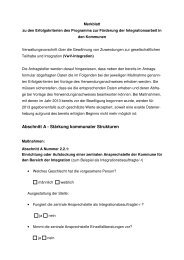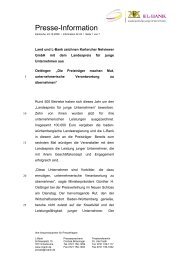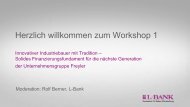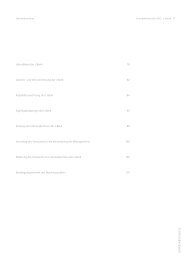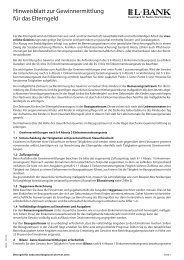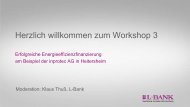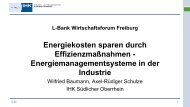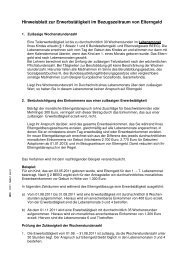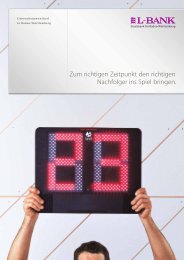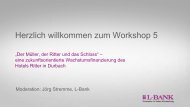Landeskreditbank Baden-Württemberg - L-Bank
Landeskreditbank Baden-Württemberg - L-Bank
Landeskreditbank Baden-Württemberg - L-Bank
You also want an ePaper? Increase the reach of your titles
YUMPU automatically turns print PDFs into web optimized ePapers that Google loves.
sheet items, other than swap transactions, forward or futures contracts and rights under option agreements, is<br />
adjusted according to their risk classification depending on the type of instrument (20, 50 and 100 percent). Swap<br />
transactions, forward or futures contracts, and rights under option agreements, along with any credit support<br />
obligation assumed in connection therewith, are taken into account according to the mark-to-market method.<br />
Under that method, the asset is taken into account with the amount required to cover (replacement value) if the<br />
counterparty defaults plus an additional amount for future increase of risk.<br />
After such adjustment of the valuation basis, the off-balance sheet items are risk-weighted in the same<br />
manner as on-balance sheet items and for that purpose are assigned to the credit risk categories depending on the<br />
type of the counterparty or the debtor and multiplied by the applicable percentage weights.<br />
Own Funds<br />
The Solvency Ratio deals with the credit risks of a bank. The German <strong>Bank</strong>ing Act also requires market risk<br />
positions of banks to be covered by adequate capital. In that regard, two concepts are used by the German<br />
<strong>Bank</strong>ing Act: (1) Own Funds (Eigenmittel) and (2) the distinction between trading transactions which are<br />
allocated to a bank’s trading book (Handelsbuch) (the “Trading Book”) and non-trading transactions which are<br />
allocated to a bank’s investment book (Anlagebuch) (the “Investment Book”).<br />
Own Funds consist of Liable Capital plus Tier III Capital. Tier III Capital consists of:<br />
(1) short-term subordinated debt (with a term of at least two years but less than five years) that meets<br />
certain conditions set forth in the German <strong>Bank</strong>ing Act, including subordination to all nonsubordinated<br />
creditors, and<br />
(2) the net profits which would be realized if, at the end of a given day:<br />
(i) all positions in the Trading Book were settled,<br />
(ii) all foreseeable expenses and distributions on capital were deducted, and<br />
(iii) all probable losses that would be incurred in the Investment Book if the bank were liquidated were<br />
deducted.<br />
The sum of Tier III Capital plus the portion of Supplementary Capital that is not required to cover risk<br />
positions in the Investment Book (in order to meet the Solvency Ratio requirement) and therefore is eligible to<br />
support market risks must not exceed 250% of the portion of Core Capital that is not required to cover risk<br />
positions in the Investment Book (in order to meet the Solvency Ratio requirement) and therefore is eligible to<br />
support market risks.<br />
Trading Book and Investment Book<br />
The Trading Book of a bank is comprised of the following:<br />
(1) securities, money market instruments, derivatives and marketable obligations and participations (all<br />
“instruments”) that are held by the bank for its own account for resale or trading;<br />
(2) instruments held and transactions entered into for the purpose of hedging the market risk of the Trading<br />
Book and transactions to refinance such hedging;<br />
(3) transactions subject to the designation of the counterparty (Aufgabegeschäfte);<br />
(4) receivables for fees, interest and dividends related to positions in the Trading Book; and<br />
(5) repurchase agreements, loans or similar transactions related to positions in the Trading Book.<br />
<strong>Bank</strong>s must establish guidelines for the inclusion of transactions in their Trading Book, which must be<br />
submitted to the BaFin and the Bundesbank. The Investment Book of a bank consists of all transactions that are<br />
not contained in the Trading Book as set forth above.<br />
39



